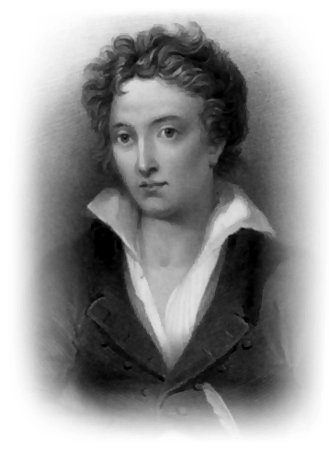 |
 |
|||
|
|
Percy Bysshe Shelley was born at Field Place in
Warnham, near Horsham in Sussex, the son of Timothy Shelley, a local member
of Parliament and afterwards a baronet, by his wife Elizabeth, the daughter
of Charles Pilfold. They were an aristocratic family descended from the
Shelleys of Michelgrove. Shelley was educated at the Syon House Academy in
Brentford (Middlesex) and Eton College (Buckinghamshire), before entering
University College, Oxford in 1810. By this time - despite the birth of a daughter, Ianthe - Shelley's marriage to Harriet was rapidly falling apart. In 1814, she left him and went to live with her father in Bath (Somerset). Shelley decided to travel abroad - in the company of a new friend, Mary Wollstonecraft Godwin, and her step-sister, Jane (alias Claire) Clairmont. Mary was the daughter of his long-term correspondent, the philosopher and anarchist, William Godwin. On the journey, Shelley wrote an unfinished novella, 'The Assassins' and their joint journal, 'Six Weeks' Tour' appeared in 1817 as reworked by Mary. After their return to London, there was a brief reconciliation with Harriet and a son, Charles Bysshe, was born at the end of 1814. The next year, Shelley's affairs took a favourable turn when he received an annual income under the terms of his grandfather's will. He took up residence at Bishopsgate (Surrey), on the edge of Windsor Great Park, and there studied Greek literature. Mary bore him his favourite son, William, in January 1816. The following Summer, the couple fled to Lake Geneva to avoid the entreaties for loans from Mary's father. There they joined Lord Byron, who enjoyed an affair with Mary's step-sister, while Shelley composed his 'Hymn to Intellectual Beauty' and 'Mont Blanc' and Mary conceived the idea for and partly wrote her 'Frankenstein'. Returning to England, they set up home in Bath (Somerset) and then Marlow (Buckinghamshire); but Shelley could not locate Harriet, who had quit her father's house. In early December 1816, she was found to have drowned herself in the Serpentine and two weeks later Shelley married Mary Wollstonecraft Godwin at St. Mildred's Church in the City, though he failed to secure custody of his two eldest children. In 1817, the Shelleys had a second child, Clara, and Mary's step-sister arrived in the household with Byron's bastard. Shelley became good friends with Leigh Hunt and wrote 'The Revolt of Islam' while enjoying the view from a high seat in Bisham Wood or anchored in his boat amongst the islets of the Thames. He also published his much anthologized 'Ozymandias' the following year, as well as further political tracts. Although, much of his time was spent engaged in relieving the poor living conditions of many of the local cottage dwellers. Becoming restless, in 1818, Shelley took his family to join Byron in settling in Italy: Turin, Como, Milan, Lucca and then Venice. The next year, they moved to Rome and then Florence where a third son, Percy Florence, was born, though sadly Mary's other two children had both already died. Shelley's works from this period include 'Julian and Maddalo' (an exploration of his relations with Byron); the lyrical drama, 'Prometheus Unbound'; 'The Cenci', a five-act tragedy based on the history of a 16th-century Roman family; 'The Mask of Anarchy', a political protest written after the Peterloo Massacre; and three of his most popular poems: the Odes 'To the West Wind' and 'To a Skylark' and his elegy for Keats called 'Adonais'. In 1820, the Shelley household moved to Pisa, where the poet remained for the rest of his life. In April 1822, they were staying on the edge of the Bay of Lerici where the poet began to write 'The Triumph of Life'. In order to welcome his friend, Leigh Hunt, Shelley sailed for Spezzia from Leghorn in the July. During a stormy return voyage to Lerici, his little schooner, the Ariel, sank and both Shelley and his friend, Edward Williams, were drowned. Their bodies were washed ashore at Viareggio where they were buried on the beach. Later, in the presence of Byron, Hunt and Trelawney, Shelley was cremated and re-interred in the Protestant Cemetery in Rome. His heart, however, would not burn and Trelawney snatched it from the flames. It was given to Mary and now lies alongside her in St Peter's Churchyard in Bournemouth (Hampshire). In 1844, twenty years after Shelley's death, his mother, Elizabeth, Lady Shelley, retired to Elcot Park at Kintbury in Western Berkshire. She died two years later, but his three sisters lived on there until the last of them died in 1887.
|
|||
| © Nash Ford Publishing 2005. All Rights Reserved. | ||||



 Percy
Bysshe Shelley (1792-1822)
Percy
Bysshe Shelley (1792-1822)